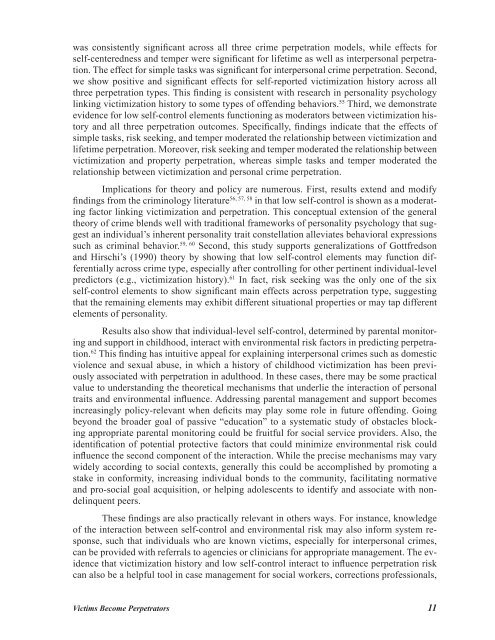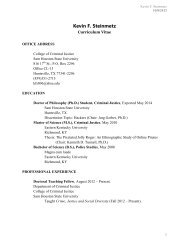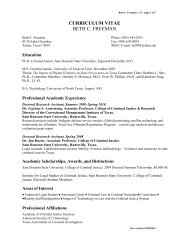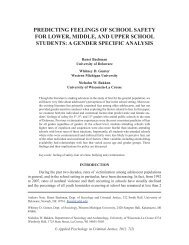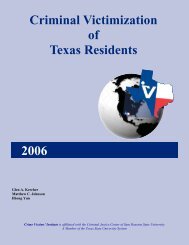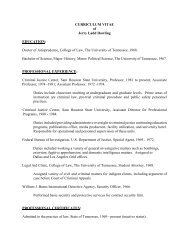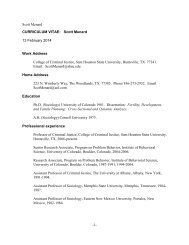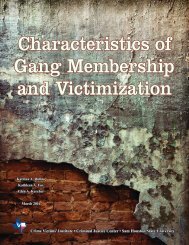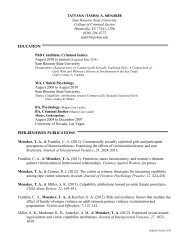Understanding How Some Victims Become Perpetrators: Self ...
Understanding How Some Victims Become Perpetrators: Self ...
Understanding How Some Victims Become Perpetrators: Self ...
Create successful ePaper yourself
Turn your PDF publications into a flip-book with our unique Google optimized e-Paper software.
was consistently significant across all three crime perpetration models, while effects forself-centeredness and temper were significant for lifetime as well as interpersonal perpetration.The effect for simple tasks was significant for interpersonal crime perpetration. Second,we show positive and significant effects for self-reported victimization history across allthree perpetration types. This finding is consistent with research in personality psychologylinking victimization history to some types of offending behaviors. 55 Third, we demonstrateevidence for low self-control elements functioning as moderators between victimization historyand all three perpetration outcomes. Specifically, findings indicate that the effects ofsimple tasks, risk seeking, and temper moderated the relationship between victimization andlifetime perpetration. Moreover, risk seeking and temper moderated the relationship betweenvictimization and property perpetration, whereas simple tasks and temper moderated therelationship between victimization and personal crime perpetration.Implications for theory and policy are numerous. First, results extend and modifyfindings from the criminology literature 56, 57, 58 in that low self-control is shown as a moderatingfactor linking victimization and perpetration. This conceptual extension of the generaltheory of crime blends well with traditional frameworks of personality psychology that suggestan individual’s inherent personality trait constellation alleviates behavioral expressionssuch as criminal behavior. 59, 60 Second, this study supports generalizations of Gottfredsonand Hirschi’s (1990) theory by showing that low self-control elements may function differentiallyacross crime type, especially after controlling for other pertinent individual-levelpredictors (e.g., victimization history). 61 In fact, risk seeking was the only one of the sixself-control elements to show significant main effects across perpetration type, suggestingthat the remaining elements may exhibit different situational properties or may tap differentelements of personality.Results also show that individual-level self-control, determined by parental monitoringand support in childhood, interact with environmental risk factors in predicting perpetration.62 This finding has intuitive appeal for explaining interpersonal crimes such as domesticviolence and sexual abuse, in which a history of childhood victimization has been previouslyassociated with perpetration in adulthood. In these cases, there may be some practicalvalue to understanding the theoretical mechanisms that underlie the interaction of personaltraits and environmental influence. Addressing parental management and support becomesincreasingly policy-relevant when deficits may play some role in future offending. Goingbeyond the broader goal of passive “education” to a systematic study of obstacles blockingappropriate parental monitoring could be fruitful for social service providers. Also, theidentification of potential protective factors that could minimize environmental risk couldinfluence the second component of the interaction. While the precise mechanisms may varywidely according to social contexts, generally this could be accomplished by promoting astake in conformity, increasing individual bonds to the community, facilitating normativeand pro-social goal acquisition, or helping adolescents to identify and associate with nondelinquentpeers.These findings are also practically relevant in others ways. For instance, knowledgeof the interaction between self-control and environmental risk may also inform system response,such that individuals who are known victims, especially for interpersonal crimes,can be provided with referrals to agencies or clinicians for appropriate management. The evidencethat victimization history and low self-control interact to influence perpetration riskcan also be a helpful tool in case management for social workers, corrections professionals,<strong>Victims</strong> <strong>Become</strong> <strong>Perpetrators</strong> 11


